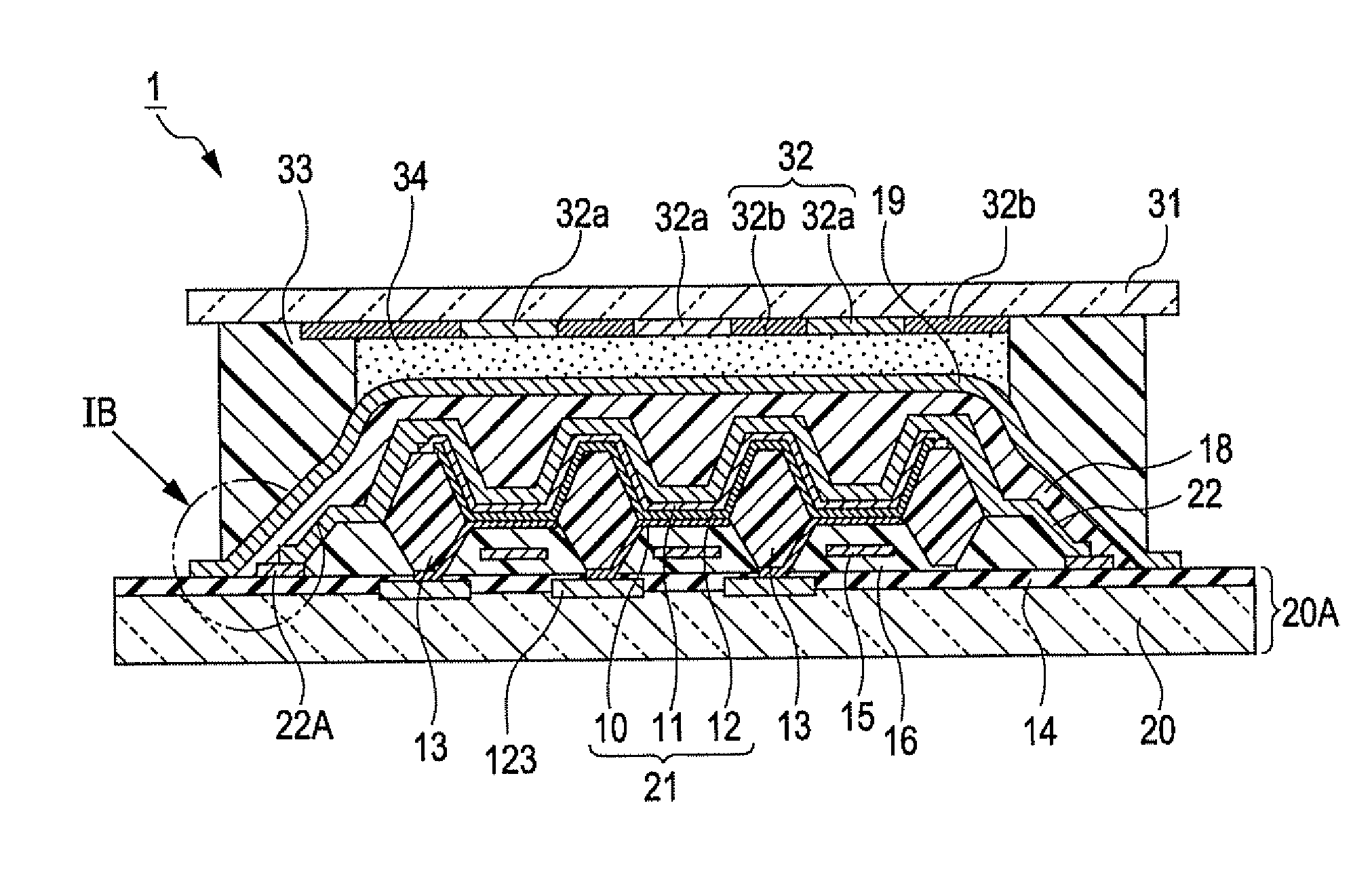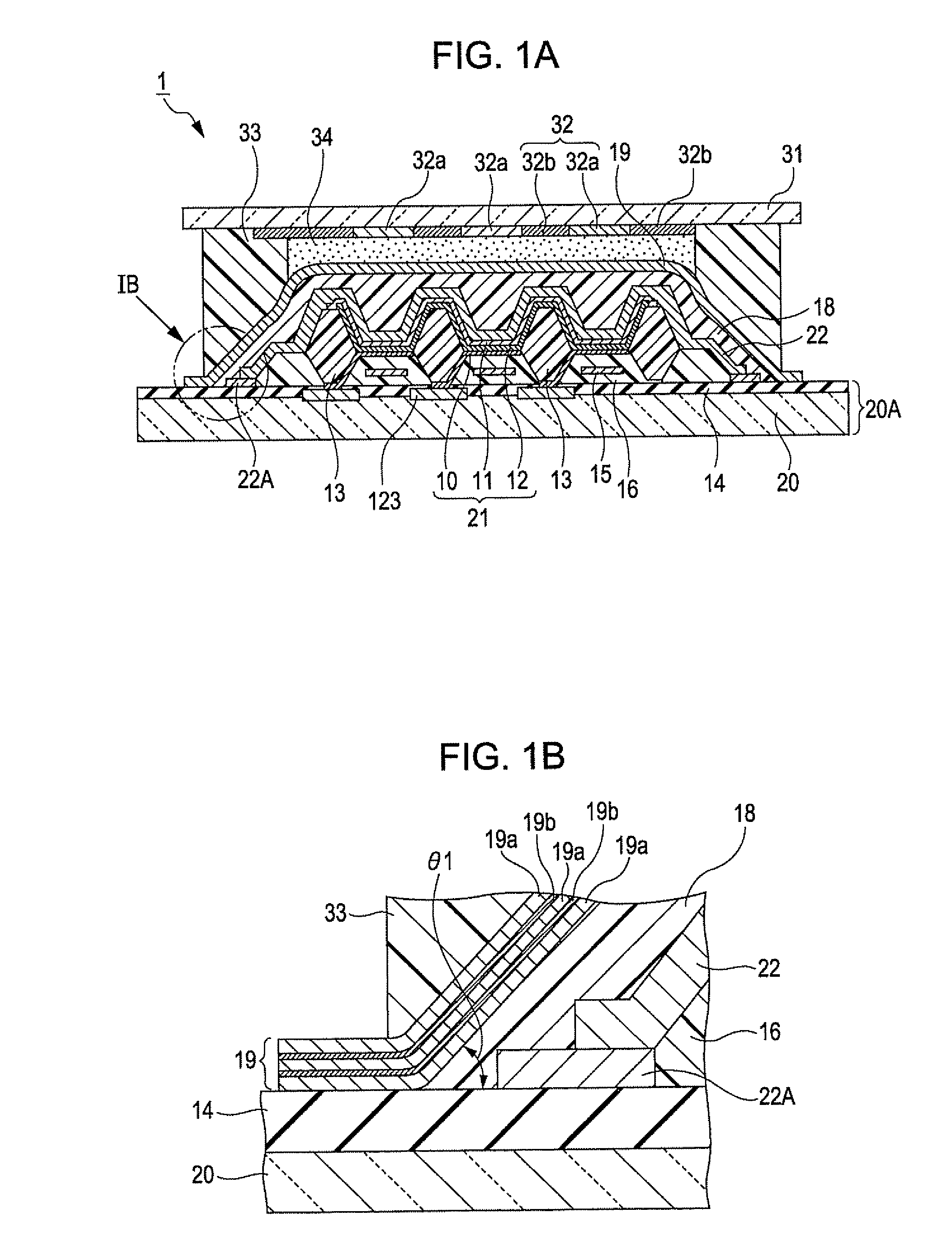Organic electroluminescence device, process of producing organic electroluminescence device, and electronic apparatus
a technology of electroluminescence device and electroluminescence device, which is applied in the direction of discharge tube luminescnet screen, discharge tube/lamp details, coating, etc., can solve the problems of low flexibility and high young's modulus of film, and achieve long product life and high endurance
- Summary
- Abstract
- Description
- Claims
- Application Information
AI Technical Summary
Benefits of technology
Problems solved by technology
Method used
Image
Examples
first embodiment
A First Embodiment
[0053]An organic electroluminescence device (organic EL device) according to a first Embodiment of the invention will now be described with reference to FIGS. 1A, 1B, 2A to 2C, 3, 4A, 4B, 5A to 5C, 6A, and 6B. Incidentally, in all the following drawings, film thickness of each component, ratios of sizes, and so on are appropriately changed for easy understanding of the drawings.
[0054]FIGS. 1A and 1B are cross-sectional views schematically showing an organic EL device 1. The organic EL device according to the invention is a so-called “top-emission-type” organic EL device. In the top emission system, light is drawn from an opposite substrate side, not from the side of a substrate on which organic EL elements are arranged. Therefore, the light emission area is not affected by the sizes of various types of circuits arranged on the element substrate, and a large light emission area can be effectively secured. Accordingly, high brightness can be secured, while suppressin...
second embodiment
[0145]FIGS. 7A and 7B are explanatory diagrams of an organic EL device according to a second Embodiment of the invention. The organic EL device of this Embodiment is partially the same as the organic EL device of the first Embodiment. A difference between them is that the auxiliary wiring does not function as the protection layer of the cathode and an electrode-protecting layer for protecting the cathode is provided. Accordingly, in this Embodiment, the same components as those in the first Embodiment are denoted by the same reference numerals, and the detailed descriptions thereof are omitted.
[0146]As shown in FIG. 7A, auxiliary cathode wiring 24 for assisting electrical conduction between a cathode 11 and cathode wiring 22A is provided at the end of the cathode 11, and an electrode-protecting layer 17 covers the entire surfaces of the cathode 11, the cathode wiring 22A, and the auxiliary cathode wiring 24. This electrode-protecting layer 17 can prevent the cathode 11 and the under...
example
[0157]An Example of the invention will now be described. In this Example, a test device for evaluation was produced as an organic EL device in order to confirm effect of the invention.
[0158]The test device used in this Example was produced by forming a magnesium film (mg film) on a glass support substrate, forming a thin-film sealing layer consisting of an electrode-protecting layer (SiON) / an organic buffer layer / a gas barrier layer so as to cover the Mg film, and bonding a glass opposite substrate to the thin-film sealing layer. The electrode-protecting layer was in contact with the support substrate so as to seal the Mg film and was also in contact with the gas barrier layer so as to seal the organic buffer layer.
[0159]The thicknesses of components of the test device used were as follows: Mg film: 50 nm, electrode-protecting layer (SiON): 400 nm, organic buffer layer: 3 μm, and gas barrier layer: 400 nm. In the test device of this Example, the gas barrier layer was composed of sta...
PUM
 Login to View More
Login to View More Abstract
Description
Claims
Application Information
 Login to View More
Login to View More - R&D
- Intellectual Property
- Life Sciences
- Materials
- Tech Scout
- Unparalleled Data Quality
- Higher Quality Content
- 60% Fewer Hallucinations
Browse by: Latest US Patents, China's latest patents, Technical Efficacy Thesaurus, Application Domain, Technology Topic, Popular Technical Reports.
© 2025 PatSnap. All rights reserved.Legal|Privacy policy|Modern Slavery Act Transparency Statement|Sitemap|About US| Contact US: help@patsnap.com



